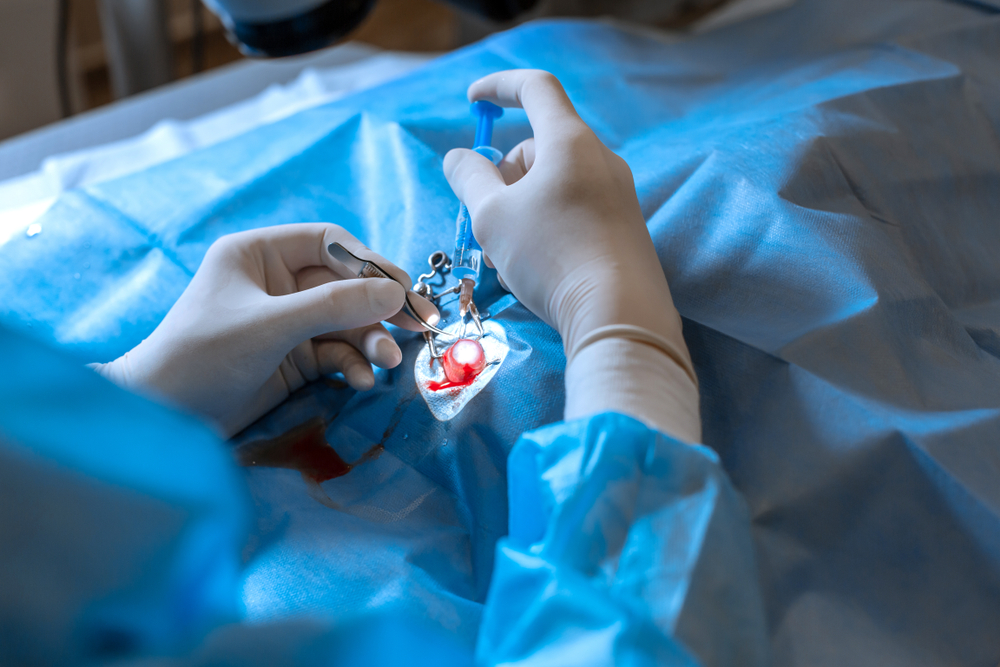Glaucoma can be a battle for pet owners, because despite treatment, many pets with glaucoma eventually lose vision in one or both eyes. Medications may be effective for some pets or for a short time, but surgery is often required to alleviate pressure and offer the pet their best chance at preservation of their long-term sight.
The Veterinary Vision Center team frequently performs glaucoma surgeries, but we know the process can overwhelm pet owners. We share what to expect before, during, and after your pet’s procedure to help you feel more comfortable with their treatment plan.
Understanding glaucoma in pets
Glaucoma is characterized by increased pressure inside the eye, which can lead to optic nerve damage and vision loss. Normally, the eye stays inflated and nourished by constantly producing fluid that eventually drains through tiny mesh-like structures where the iris and cornea meet. If the drains do not form normally or become clogged, fluid and pressure build up. Glaucoma can be a primary problem in many dog breeds or may be caused secondarily to eye trauma, inflammation, or disease.
Medical versus surgical treatments for glaucoma in pets
Glaucoma can be treated medically, surgically, or in combination. Each treatment is aimed at reducing eye fluid production or increasing fluid drainage to normalize eye pressure and preserve vision. This can be accomplished effectively with several eye drop medications, but they must be applied on a strict schedule to prevent pressure from creeping up again. Eventually, eye pressure may spike despite medications, and then surgery is recommended.
The decision to pursue glaucoma surgery is personal and depends on your pet’s circumstances. Although vision-sparing surgeries can prevent eye pressure spikes and preserve vision, they have high complication and failure rates. Therefore, we typically wait to perform surgery until we have exhausted other treatment options.
Surgical procedures available for treating glaucoma in hopes of preserving or restoring vision include laser destruction of the fluid-producing eye cells and shunt placement to provide fluid drainage. We may recommend one or both surgeries be performed for an optimal outcome. Once an eye has permanently lost vision from glaucoma, the focus shifts from preserving vision to eliminating discomfort through eye removal surgery or outpatient eye injection procedures.
Preparing your pet for glaucoma surgery
Before surgery, our team will discuss the procedure, potential risks, and expected outcomes with you. Glaucoma surgery is not the right choice for all pets or pet owners, and we want to ensure you choose a treatment plan that makes you comfortable. Once we arrive at a decision together, we will run blood tests or check with your primary veterinarian to ensure anesthesia and surgery are safe for your pet.
What happens during your pet’s glaucoma surgery
On the day of surgery, your pet will be dropped off at our center in the morning and stay for the day. A nursing team member assigned to the case will provide all necessary pre-surgical eye drops, pain medication, and sedatives, and will monitor your pet closely during surgery to ensure a smooth, pain-free recovery.
Surgery can take up to two hours, depending on the specific procedure performed and whether both or only one eye is treated. Because eye surgery requires precise movements and delicate instruments and sutures, our veterinarians use a large surgical microscope to view the eye in detail. In most cases, we must make an incision on the cornea into the eye and then close the incision with tiny sutures when the procedure is done.
Glaucoma surgeries are invasive procedures that cause trauma and inflammation inside the treated eye, which is the reason for potential complications and lower success rates. After surgery, your pet’s eye pressure could increase or their retina could detach, resulting in blindness. Sometimes, glaucoma surgery must be repeated to control pressure. Overall, somewhere between 50% and 90% of dogs still have vision one year after their surgery. Our team will discuss our expected success rate depending on your pet’s particular case.
Recovery and eye health monitoring after pet glaucoma surgery

After surgery, your pet will go home with instructions to continue their anti-glaucoma eye drops. We will also send home pain medications and strong anti-inflammatories to improve comfort and reduce complication risk. We will require frequent follow-up visits to check your pet’s eye pressure and monitor the health of their internal eye structures that were disturbed during surgery. Following our team’s instructions and follow-up schedule is crucial for successful outcomes.
Your pet undergoing glaucoma surgery can be a scary prospect, but the Veterinary Vision Center team is here to answer your questions and ensure your pet has the best possible outcome. Contact us to schedule a visit if you are concerned about your pet’s eye health or vision, or to learn more about long-term glaucoma management.







Leave A Comment